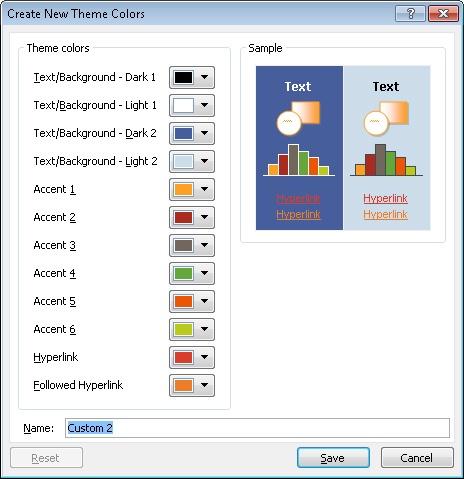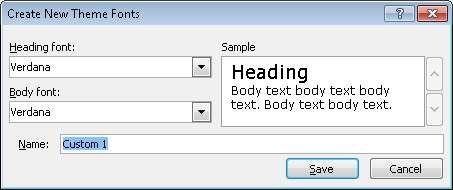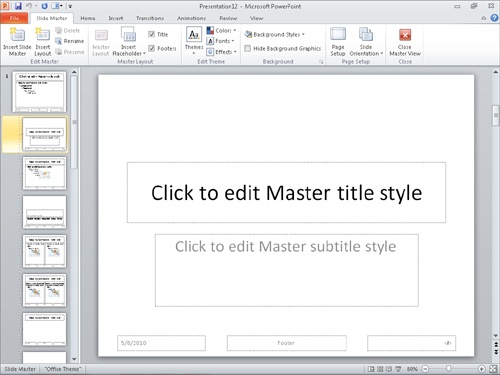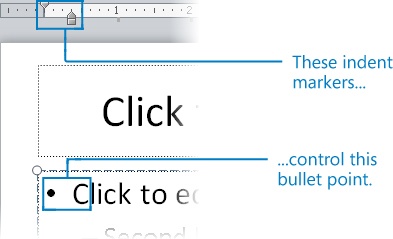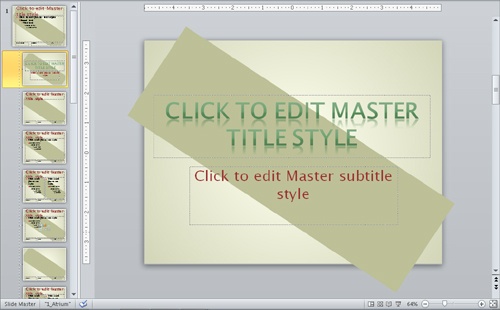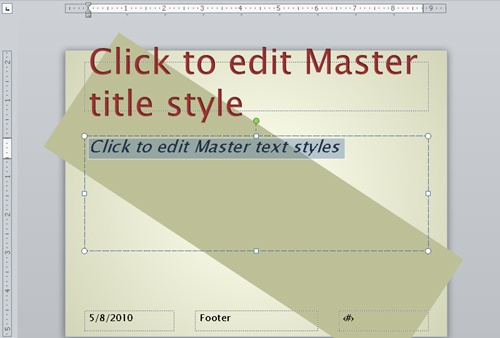In this chapter, you will learn how to | |
|---|---|
✓ | Create theme colors and fonts. |
✓ | View and change slide masters. |
✓ | Create slide layouts. |
✓ | Save custom design templates. |
In addition to using the built-in design elements of Microsoft PowerPoint 2010, you can create your own color schemes, font sets, layouts, and templates. Why would you want to create your own elements rather than using those that come with PowerPoint? If your organization has established a corporate or brand image through the use of a logo, a color scheme, or other visual cues, you might be required to incorporate that branding into presentations that will be seen outside the organization. Even if branding is not an issue, you might want to establish a unique look for all your presentations to identify your work.
In this chapter, you’ll create a color scheme and font set and then save the color/font combination as a new theme. You’ll view and edit the slide masters for a presentation, changing the layout, text formatting, and bullet formatting, and adding a picture to the background. You’ll then create a master layout, save a presentation as a design template, and create a presentation based on the template.
Practice Files
Before you can complete the exercises in this chapter, you need to copy the book’s practice files to your computer. The practice files you’ll use to complete the exercises in this chapter are in the Chapter13 practice file folder. A complete list of practice files is provided in Using the Practice Files at the beginning of this book.
One simple way to dress up a presentation is to apply a theme to make its colors, fonts, formatting, graphics, and other elements consistent from slide to slide. You can then switch to a different predefined color scheme and font set without otherwise affecting the overall look of the theme.
If none of the ready-made color schemes or font sets meets your needs, you can create your own and use it with any theme. If you want to be able to use your custom color scheme/font set combination with other presentations, you can save the combination as a new theme that you can then apply to another presentation with a few clicks of the mouse button.
Tip
You can set a custom theme, or any theme, as the default for all new presentations by right-clicking the theme’s thumbnail in the Themes gallery and then clicking Set As Default Theme.
The simplest way to create a color scheme or font set is by altering an existing one. After you add the new scheme to the Colors gallery or font set to the Fonts gallery, you can apply it to an entire presentation by clicking the scheme in the Custom section of the gallery. You can apply it to the current slide only by right-clicking it and then clicking Apply To Selected Slides.
Tip
You don’t have to create a custom color scheme or font set to be able to apply the particular combination of colors or fonts used on one slide to another slide. You can display the slide with the formatting you want to reuse, click the Format Painter button in the Clipboard group on the Home tab, and then click the slide to which you want to copy the formatting.
In this exercise, you’ll create a color scheme and font set for a photo album and make them available for reuse. Then you’ll save the color/font combination as a new theme that you can apply to any presentation.
Display the New page of the Backstage view, click Sample Templates, and double-click Classic Photo Album. Then save the presentation with the name My Photo Album.
This presentation is very somber. Let’s keep the classic look but make it more lively.
On the Design tab, in the Themes group, click the Colors button.
The Colors gallery appears. The Technic color scheme is currently applied to the presentation.
In the gallery, click the Pushpin color scheme.
This scheme has some interesting colors, but the presentation title is too sedate.
In the Themes group, click the Colors button, and then at the bottom of the gallery, click Create New Theme Colors.
The Create New Theme Colors dialog box opens.
Click the Text/Background - Light 2 box to display a color palette.
Under Theme Colors, click the fifth box in the top row (Orange, Accent 1).
The Sample pane changes to show the new color combination.
Click the Accent 1 box, and under Theme Colors in the palette, click the fourth box in the top row (Ice Blue, Text 2).
You have switched the two colors.
Click the Text/Background - Light 1 box, and at the bottom of the palette, click More Colors.
The Colors dialog box opens.
If the Standard tab is not displayed, click it.
This tab displays a color wheel.
In the color wheel, click a lime green color, and then click OK.
In the Name box at the bottom of the Create New Theme Colors dialog box, change the name of the new theme to My Custom Colors, and then click Save.
PowerPoint applies the change to the slides and adds a theme with the new color scheme to the left end of the Themes gallery.
Troubleshooting
Sometimes PowerPoint doesn’t update the text of the slides with the new color scheme. If that happens, click the text placeholder, press Ctrl+A to select all its text, and then press Ctrl+Spacebar. This removes any local formatting and reapplies the formatting defined in the attached theme.
In the Themes group, click the Fonts button, and then in the Fonts gallery, click Aspect as a starting point for a new font set.
Click the Fonts button again, and then at the bottom of the gallery, click Create New Theme Fonts.
The Create New Theme Fonts dialog box opens.
Click the Heading font arrow, and then in the list, click Arial Rounded MT Bold.
The Sample pane shows the new font combination.
In the Name box at the bottom of the dialog box, change the name of the new font set to My Custom Fonts, and then click Save.
In the Themes group, click first the Colors button and then the Fonts button, and notice that your combinations are listed under Custom in the respective galleries.
In the Themes group, click the More button, and then at the bottom of the gallery, click Save Current Theme.
The Save Current Theme dialog box opens, displaying the contents of your Document Themes folder. Saving custom themes in this folder ensures that they are available in the gallery for use in other presentations.
In the File name box at the bottom of the dialog box, change the name of the new theme to My Theme, and then click Save.
Save the My Photo Album presentation, and then close it.
Open a new, blank presentation. Then on the Design tab, in the Themes group, point to the second thumbnail in the gallery.
PowerPoint displays the ScreenTip My Theme below the thumbnail.
Click the My Theme thumbnail to apply the custom theme to the new presentation.
When you create a presentation, the slides take on the characteristics of the template on which it is based. PowerPoint templates use masters to determine their basic design. By default, PowerPoint presentations have three masters:
Slide master. This set of masters controls the look of all the slides in a presentation, including the theme, text placement, background graphics, and other slide elements. The set contains a master design for most of the layouts you are likely to use.
Handout master. This master controls the look of any handouts you prepare for distribution to your audience.
Notes master. This master controls the look of speaker notes (if you choose to print them).
See Also
For information about handouts and speaker notes, see Preparing Speaker Notes and Handouts in Chapter 6.
When you create a presentation, its slides assume the design of its corresponding set of slide masters. The slide masters contain placeholders for a title, bullet points, or other content, depending on the particular layout. Most slide masters also contain placeholders for the date and time, footer information, and slide number. The placeholders control the position of the elements on the slide. Text placeholders also control the formatting of their text.
On an individual slide, you can make changes to the design elements provided by the master, but you can change the basic design only on the master. When you change a design element on the master, all the slides reflect the change.
Tip
To override the master design for a particular slide, you use commands on the Home and Design tabs. For example, you can remove a background graphic from a slide by clicking the Hide Background Graphics button in the Background group on the Design tab.
To make changes to a presentation’s masters, you need to switch to Slide Master view by clicking the Slide Master button in the Master Views group on the View tab. In this view, the Overview pane on the left displays the primary master, which controls the base layout, followed by all the available layout variations. The layout selected in the Overview pane is displayed in the Slide pane on the right. PowerPoint adds a Slide Master tab to the ribbon and hides the tabs that aren’t needed in this view.
Troubleshooting
The appearance of buttons and groups on the ribbon changes depending on the width of the program window. For information about changing the appearance of the ribbon to match our screen images, see Modifying the Display of the Ribbon at the beginning of this book.
By clicking buttons on the Slide Master tab, you can make the following adjustments:
Make another set of masters available to the presentation and preserve that set so that it remains available even if it is not currently used in the presentation.
Add a new layout with the same background, title, and footer style to which you can add your own placeholders.
Delete or rename a selected layout.
Specify which placeholders will be included on the selected layout.
Select and fine-tune the theme applied to the master set.
Control the background color, texture, and graphics.
Set the default page setup for the presentation.
Clicking the Close Master View button in the Close group on the Slide Master tab returns you to the view from which you switched to Slide Master view. You can also click any view button on the View Shortcuts toolbar at the right end of the status bar to close Slide Master view.
While you are working in Slide Master view, you can use the buttons on the other tabs in the following ways:
Format a text placeholder on a master by selecting it and then clicking buttons in the Font and Paragraph groups on the Home tab.
Add objects such as graphics and WordArt text to a master by clicking buttons on the Insert tab.
Apply transitions by clicking buttons on the Transitions tab.
Animate parts of a slide by clicking buttons on the Animations tab.
Use the proofing and language tools on the Review tab.
For slides designed to contain text, you can format bulleted lists by specifying the bullet’s size, shape, and color. You can also control the indenting of various bullet levels and the distance between the bullet and its text by displaying the rulers and moving markers, as follows:
First Line Indent. The upper triangle controls the first line of the paragraph.
Hanging Indent. The lower triangle controls the left edge of the remaining lines of the paragraph.
Left Indent. The small square controls how far the entire paragraph sits from the edge of the text object.
To adjust the relationship between the first and remaining lines of a bullet point, you drag the First Line Indent and Hanging Indent markers to the left or right on the ruler. To adjust the distance of the bullet point from the edge of the text object, you drag the Left Indent marker.
In this exercise, you’ll view a presentation’s masters in Slide Master view. Then you’ll add a graphic to the background, change character formatting, and change the font scheme. Then you’ll change bullet characters and adjust bullet spacing. Finally, you’ll remove the footer placeholders from the title slide layout.
Set Up
You need the NaturalMaster_start presentation located in your Chapter13 practice file folder to complete this exercise. Open the NaturalMaster_start presentation, and save it as NaturalMaster. Display the rulers, and then follow the steps.
With slide 1 displayed in Normal view, on the View tab, in the Master Views group, click the Slide Master button.
You are now in Slide Master view. The Overview pane on the left shows thumbnails of the primary master and the layouts in this set. The first layout—the Title Slide layout, which controls the presentation’s title slide—is selected and appears in the Slide pane to the right. Notice that, other than the gradient background, the masters don’t reflect the formatting of the slides, which has been applied manually on a slide-by-slide basis. Let’s implement the formatting in the masters so that we don’t have to do it manually on each slide.
On the View Shortcuts toolbar, click the Normal button. Then on slide 1, click the diagonal shape to select it, and copy it.
See Also
For more information about keyboard shortcuts, see Appendix A at the end of this book.
Switch back to Slide Master view. Then in the Overview pane, click the primary master (the top thumbnail), and paste the diagonal shape into that master.
Because the primary master controls the basic characteristics of all the layouts, the graphic fills their backgrounds as well. The shape is selected, so PowerPoint adds the Format contextual tab to the ribbon.
On the Format tab, in the Arrange group, click the Send Backward arrow, and then click Send to Back.
PowerPoint moves the shape behind the other elements on the primary master.
Switch to Normal view, and on slide 1, select and delete the shape that was drawn manually on the slide.
The appearance of the slide remains the same, because the shape is now supplied by the slide master.
Click anywhere in the title placeholder, select all the text, and then on the Home tab, in the Clipboard group, click the Format Painter button.
Switch back to Slide Master view, where the Title Slide layout is selected by default, and drag the Format Painter pointer across the text in the placeholder for the presentation’s title.
PowerPoint copies the local character formatting of the title on slide 1 to the master Title Slide layout.
Enlarge the title placeholder by dragging its handles upward and toward the edges of the slide. Then click away from the placeholder to see the result.
The newly formatted title fits on two lines.
Repeat steps 6 and 7 to copy the formatting of the subtitle on the presentation’s title slide to the master Title Slide layout.
Repeat steps 6 and 7 again to copy the formatting of the title of slide 2 in the presentation to the title of the primary master.
PowerPoint copies the character formatting of slide 2’s title to the primary master’s title, and in the Overview pane, all the layouts with slide titles now reflect this change.
With the primary master still selected, on the Slide Master tab, in the Edit Theme group, click the Fonts button, and then in the Fonts gallery, click Concourse.
The primary master and all the layouts change to reflect the new font scheme.
In the bulleted list placeholder, click anywhere in the phrase Click to edit Master text styles. Then on the Home tab, in the Paragraph group, click the Bullets arrow, and at the bottom of the gallery, click Bullets and Numbering.
The Bullets And Numbering dialog box opens.
Click Picture.
The Picture Bullet dialog box opens.
Scroll through the gallery of images, click any dark red image you like, and then click OK.
We chose the red sunburst toward the bottom of the gallery.
Click anywhere in the phrase Second level, display the Bullets and Numbering dialog box, and click Customize.
The Symbol dialog box opens.
Change the Font to Wingdings, and double-click a symbol that is compatible with the picture you selected for the first-level bullet.
Back in the Bullets and Numbering dialog box, set the Color of the new bullet to Dark Red and its Size to 90, and then click OK.
All the layouts with bulleted lists reflect your changes.
Click the first-level bullet point, and on the horizontal ruler, drag the Hanging Indent marker to the right to the 0.5 inch mark. Then click the second-level bullet point, and drag its Hanging Indent marker to the 1 inch mark.
The First Line Indent marker remains where it is, but the Left Indent marker moves with the Hanging Indent marker.
Display the Title Slide layout, and on the Slide Master tab, in the Master Layout group, clear the Footers check box.
The date, footer information, and slide number placeholders are removed from the Title Slide layout.
Switch to Normal view, and display each slide in turn, noticing the effects of your changes to the slide masters.
PowerPoint 2010 comes with many standard layouts—enough to suit most presentations. However, one of the slides in a presentation might require a completely different layout. If the same custom layout is likely to be used more than once in a presentation, you can save time by adding the layout to the slide master set so that you can use it anytime you need it. Clicking the Insert Layout button in the Edit Master group on the Slide Master tab adds a new layout to the master set, with a title but no other content. You can then insert placeholders and arrange and format them the way you want them.
In this exercise, you’ll create a master layout with placeholders for a title and a paragraph of text. Then you’ll create another master layout with placeholders for a title and pictures.
Set Up
You need the NaturalLayout_start presentation located in your Chapter13 practice file folder to complete this exercise. Open the NaturalLayout_start presentation, and save it as NaturalLayout. Then follow the steps.
Switch to Slide Master view. Then with the Title Slide layout displayed, on the Slide Master tab, in the Edit Master group, click the Insert Layout button.
PowerPoint adds a new layout after the Title Slide layout.
In the Master Layout group, click the Insert Placeholder arrow.
The Placeholder gallery appears.
In the Placeholder gallery, click Text. Then move the cross pointer over the slide, and drag to create a text placeholder the width of the title placeholder and about 3 inches high.
Use the vertical ruler to judge the placeholder’s size, and drag from about the upper 1.5 inch mark to the lower 1.5 inch mark.
In the text placeholder, point to the bullet to the left of Fifth level, and when the cursor changes to a four-headed arrow, click to select the bullet point. Then press Delete.
Repeat step 4 for Fourth level, Third level, and Second level.
With the cursor at the end of the first-level bullet point, on the Home tab, in the Paragraph group, click the Bullets arrow. Then when the Bullets gallery appears, click None.
With the placeholder still selected, select all the text, and then in the Font group, click the Italic button.
The text placeholder is now formatted to display an italic paragraph, instead of a bulleted list.
On the Slide Master tab, in the Master Layout group, click the Insert Layout button to add another layout to the master set.
Switch to Normal view, and display slide 3. Then select the cat, crow, and frog pictures, and copy them.
Switch to Slide Master view, display the new master layout (the third one), and paste in the pictures.
The pictures now appear on the layout master.
To make it easier to add pictures to slides with this layout, let’s replace the pictures with placeholders.
Click the frog picture, and on the Format contextual tab, in the Arrange group, click the Selection Pane button to open the Selection and Visibility task pane.
Notice that the frog picture is designated as Picture 5.
On the Slide Master tab, in the Master Layout group, click the Insert Placeholder arrow, click Picture in the gallery, and then drag a picture placeholder directly on top of the frog picture.
PowerPoint adds a Picture Placeholder to the Shapes On This Slide list in the Selection And Visibility task pane.
In the task pane, click Picture 5, and then press Delete.
The frog picture is deleted, leaving the picture placeholder occupying its spot in the slide.
Repeat steps 11 through 13 to replace the crow and cat pictures with picture placeholders. Then close the Selection and Visibility task pane.
Select the bottom picture placeholder, and on the Format tab, in the Shape Styles group, use the Shape Outline command to give the placeholder a Dark Red frame that is 3 pt wide.
Use the Format Painter command to copy the frame of the bottom picture placeholder to the other two picture placeholders.
This layout now accommodates any three pictures arranged diagonally on the slide.
With the picture layout still selected, on the Slide Master tab, in the Edit Master group, click the Rename button.
The Rename Layout dialog box opens.
In the Layout name box, type My 3-Picture, and then click Rename.
On the Overview tab, point to the layout.
PowerPoint displays a ScreenTip with the name of the layout.
Repeat steps 17 and 18 to rename the first layout master you created as My Text Paragraph.
Switch to Normal view. Then with slide 3 selected, click the New Slide arrow.
The New Slide gallery appears.
In the gallery, click My Text Paragraph. Then add another slide, clicking My 3-Picture in the gallery.
Test the new layouts by adding a title and a paragraph to slide 4 and a title and pictures to slide 5.
We added the photographs from Rugged Country Plants that you will find in your Chapter13 practice file folder to slide 5.
Suppose you have spent a lot of time customizing the masters of a particular presentation and you think you might want to use the new design for future presentations. Or suppose your company requires that all official presentations use a customized set of masters that include a logo, contact information, a specific background, and bullets and text in colors that reflect the company’s branding. In cases like these, you can save a customized presentation as a design template. You can then use it as the basis for new presentations by clicking My Templates on the New page of the Backstage view and then double-clicking the custom template in the New Presentation dialog box.
Tip
For a template to be available in the New Presentation dialog box, it must be stored in the default Templates folder. If you store a template in a different folder, you can browse to that folder and double-click the template file to start PowerPoint and open a new presentation based on the template.
In this exercise, you’ll save a presentation as a template and then create a presentation based on the template.
Set Up
You need the NaturalTemplate_start presentation located in your Chapter13 practice file folder to complete this exercise. Open the NaturalTemplate_start presentation, and save it as NaturalTemplate. Then follow the steps.
Display the Save & Send page of the Backstage view, and in the center pane, click Change File Type.
In the right pane, click Template, and then at the bottom of the pane, click Save As.
The Save As dialog box opens with the Save As Type option already set to PowerPoint Template.
In the File name box, type Natural.
Navigate to your C:Users<username>AppDataRoamingMicrosoftTemplates folder, and then on the toolbar, click New folder.
With the name New folder selected, type Design Templates, and press Enter.
Double-click the Design Templates folder, and click Save.
PowerPoint saves the template in the specified folder. You can now edit the template and save it as you would any other presentation.
With the title slide displayed, select all the text in the title placeholder, and press the Delete key. Then click away from the placeholder.
In place of the title, you now see the instruction to click to add the presentation’s title.
Repeat step 7 for the subtitle.
On the Slides tab in the Overview pane, click slide 2. Then hold down the Shift key, and click slide 5.
With slides 2 through 5 selected, press Delete.
The template now contains only the title slide.
On the Quick Access Toolbar, click the Save button, and then close the template.
Display the New page of the Backstage view, and in the top row of the center pane, click My templates.
When the New Presentation dialog box opens, click the Design Templates tab, and then click (don’t double-click) the Natural template.
PowerPoint displays a thumbnail of the template in the Preview pane.
Click OK.
PowerPoint opens a new presentation based on your custom template.
On the Home tab, in the Slides group, click the New Slide arrow, and then in the New Slide gallery, click the My Text Paragraph layout.
Add one slide of each layout to the presentation, and then display each in turn to see what it looks like.
If the themes, color schemes, and font sets that come with PowerPoint 2010 don’t meet your needs, you can create your own and then make any combination available to all your presentations as a custom theme.
The slide master set controls the basic design of all slides in a presentation. You can make global changes by editing text and objects on the primary master and on the layout variations in the set.
To create your own layouts, you can manipulate existing objects on the masters. Or you can add an entirely new layout and build it from scratch.
After setting up a presentation to look the way you want, you can save it as a design template for use as the basis for other presentations.


